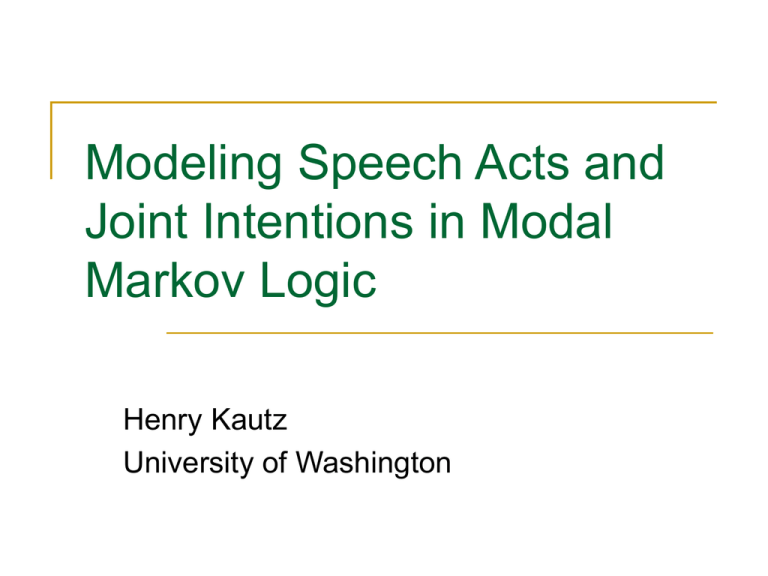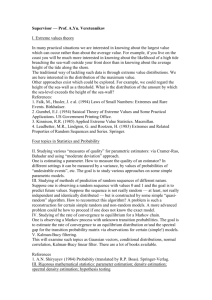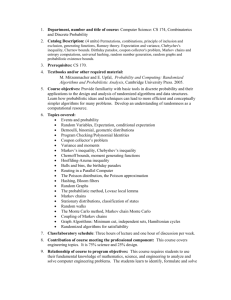Modeling Speech Acts and Joint Intentions in Markov Logic
advertisement

Modeling Speech Acts and Joint Intentions in Modal Markov Logic Henry Kautz University of Washington Goal Unified way to specify and reason about Communicative actions Domain specific actions Joint and individual obligations Beliefs of agents about other agents Criteria Handle uncertain and incomplete knowledge Support well-founded and efficient inference Support learning Markov Logic Language for statistical-relational learning Developed by Pedro Domingos [2004+] Clausal (CNF) syntax Clauses may be hard or soft Weights of soft clauses are learned from examples Semantics: compilation to a Markov model Example Advantages of Markov Logic Expressive power of (finite domain) first-order logic Ontologies: project_review(x) => meeting(x) Relations: manages(Bill,CALO) Rules: manages(x,y) & DARPA_project(y) => has_headache(x) Dynamic worlds: at(A,L1,i) & go(L1,L2,i,j) => at(A,L2,j) Supports both weight and structure learning Very efficient local-search algorithms for computing most likely assignment (MPE) Language of CALO Probabilistic Consistency Engine (Uribe & Dietterich) What’s Missing? Consider representing the felicity conditions for the speech act Ask_If(S,H,P): Preconditions: Speaker does not know whether P holds Speaker wants to know whether P holds Speaker believes Hearer knows whether P holds Effects Hearer believes Speaker wants to know whether P holds Modal Logic Logics for representing attitudes such as Knows, Believes, Wants, Ought, … Traditionally formalized by rules & axiom schemas, e.g.: If p can be deduced, then Bp (necessitation) B(p => q) => (Bp => Bq) (distribution) Bp => BBp (introspection) … Issues in Adding Modalities to Markov Logic ML is not a deductive system: consequences follow from probabilistic semantics There cannot be an explicit rule of necessitation; instead, must follow from probabilistic semantics ML only defined for finite structures Distribution (and other axiom schemas) must not require infinite instantiations Modal Markov Logic Ba Ba P means agent a believes P Need not be certain belief Intuitively: the agent’s belief is actionable Syntax KB = conjunction of weighted clauses Clause = disjunction of literals Literal = Atom or ~Atom Atom = Proposition or Ba(Clause) Extend to quantification over sets of constant terms Inference Given a KB and a query, construct a Markov graph with Nodes for each (ground) atom and its negation Weighted hyperedges for each top-level clause Unweighted (strict) hyperedges connecting each modal atom to the atoms for its disjuncts, and to the negations of its disjuncts Enforce consistency Enforce distribution Example ~B~p v ~Bp B ~p ~B~q v ~Bq Bp Bq B~p & B(p v q) => Bq B ~q B~q & B(p v q) => Bp B(p v q) Uses of soft rules: speech acts Practically all preconditions and effects of communication acts are non-categorical E.g.: you may ask a question whose answer you already know the answer Exceptions (and exceptions to exceptions…) need not be explicitly written into each rule Higher-weighted rules can over-rule lower weighted rules Can learn weights (& rules!) corresponding to different styles of discourse Uses of soft rules: joint obligations Let M(a,b,g,i) = at time i, agent a is obliged to agent b to perform g Simple soft persistence axiom: M(a,b,g,i) => does(a,g) v M(a,b,g,i+1) A purely logical persistence rule for obligations would be extremely complex Such complexities (what if b dies? what is g becomes impossible? etc) can be added as needed as additional soft rules Uses of soft rules: plan recognition & cooperative behavior Let W(a,p) = agent a wants p Cooperative agents Try to recognize the goals of other agents W(a,p) & enables(p,q) => W(a,q) Adopt those goals as their own (under proper circumstances) B(a,W(b,g)) & cooperative(a,b) => W(a,g) Status 2nd generation (non-modal) UW Markov Logic engine has been released Working on proofs of soundness & completeness of modal extension Next steps Implement Markov graph instantiation routines for modalities Hand-code speech act, obligation persistence, and (simple) plan-recognition rules Create or find annotated discourse transcripts and use to train weights Extend SRI/ICSI annotated corpus to include annotations about agents’ mental state, as well as dialogs acts





